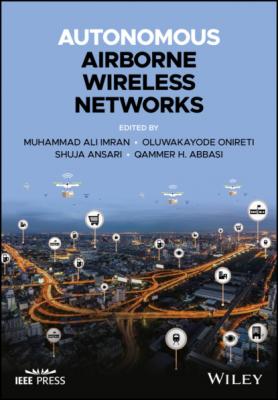Autonomous Airborne Wireless Networks. Группа авторов
Чтение книги онлайн.
Читать онлайн книгу Autonomous Airborne Wireless Networks - Группа авторов страница 14
 alt="upper P Subscript upper R Baseline equals upper P Subscript upper T Baseline upper G Subscript upper T Baseline upper G Subscript upper R Baseline left-parenthesis StartFraction lamda Subscript c Baseline Over 4 pi d EndFraction right-parenthesis squared comma"/>
alt="upper P Subscript upper R Baseline equals upper P Subscript upper T Baseline upper G Subscript upper T Baseline upper G Subscript upper R Baseline left-parenthesis StartFraction lamda Subscript c Baseline Over 4 pi d EndFraction right-parenthesis squared comma"/>
where
(2.3)
Air‐to‐Ground Channel In urban environment, the AG channel may not experience complete free space propagation. In the existing literature on UAV communications, the log‐distance model is the prominently used path loss model due to its simplicity and applicability when environmental parameters are difficult to define. Therefore, path loss in dB is given by
(2.4)
where
Another popular channel model to characterize the AG propagation in UAV communications is the probabilistic path loss model in [4] and [17]. In [17], the path loss between the ground device and the UAV is dependent on the position of the UAV and the propagation environments (e.g. suburban, urban, dense‐urban, high‐rise). Consequently, during the AG radio propagation, the communication link can be either LoS or NLoS depending on the environment. Many of the existing works [18–35] on UAV communications adopted the probabilistic path loss model of [4] and [17]. In these works, the probability of occurrence of LoS and NLoS links are functions of the environmental parameters, height of the buildings, and the elevation angle between the ground device and the UAV. This model is based on environmental parameters defined in the recommendations of the International Telecommunication Union (ITU). In particular, ITU‐R provides statistical parameters related to the environment that determine the height, number, and density of the buildings or obstacles. For instance, in [36], the height of the buildings can be modeled by using the Rayleigh distribution. The average path loss for the AG propagation in [17] is given as
(2.5)
where
Table 2.2 Measurement campaigns to characterize the path loss and large‐scale AG propagation fading.
| References | Scenario |
|
|
|
|---|---|---|---|---|
| Yanmaz et al. [8] | Urban/Open field | 2.2–2.6 | — | — |
| Yanmaz et al. [9] | Open field | 2.01 | — | — |
| Ahmed et al. [10] | — | 2.32 | — | — |
| Khawaja et al. [11] | Suburban/Open field | 2.54–3.037 | 21.9–34.9 | 2.79–5.3 |
| Newhall et al. [12] | Urban/Rural |
|